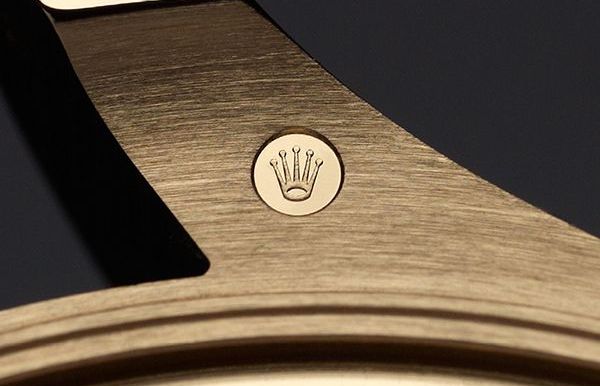
Rolex Hallmarks Complete Guide
Hallmarks can be seen stamped on all types of items. Rolex, in this case, is a Swiss watchmaker and therefore follows Swiss laws and regulations. The Swiss hallmarking system came into place in 1881. Prior to this, jewelry and watches made in gold carried hallmarks, but there was no consistent usage.
What are Rolex hallmarks?
Hallmarks are different kinds of stamps and engravings that are done on precious metals, including gold, silver, platinum, and palladium, in accordance with laws and regulations. The process of marking something according to its precious metal fineness is what is known as hallmarking. Different countries have different laws regarding hallmarks, but as Rolex is made in Switzerland, it follows Swiss hallmark laws. Furthermore, they may also need to follow other countries’ laws regarding hallmarks when importing watches into that country.
But what do the different Rolex hallmarks mean, and where are they located?
In this article, you will learn everything you need to know about Rolex’s hallmarks.
Rolex hallmarks
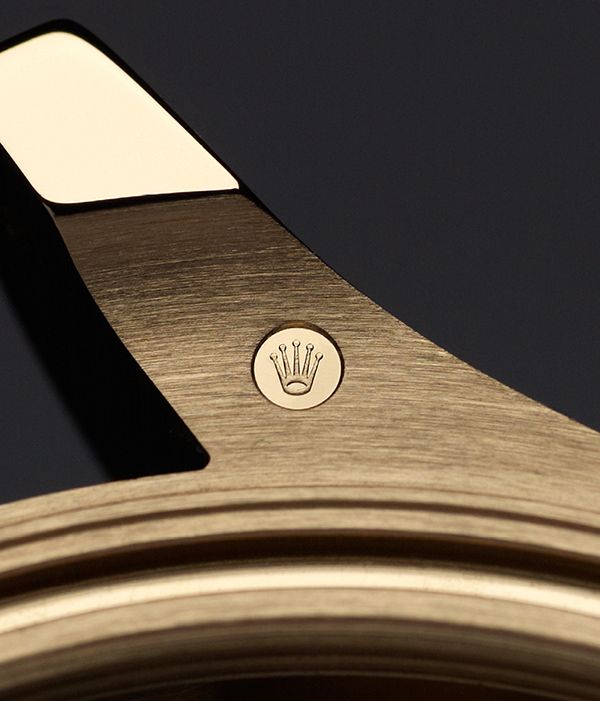
The standards for precious metals derive back to the 15th century, originating in Geneva. At the time, as mentioned, there was no consistent usage of hallmarks. The first indications of regulation of precious metal regulations and hallmarking date back to 1424 and were introduced by Bishop John of Brogny. What made it difficult to understand the hallmarks is that each of them had its own standards as well as its own hallmarking system for precious metals. The first official signs of regulation were in 1815, when an Assay Office was established in Geneva on September 22, 1815, and one in Neuchâtel in 1839, under the government.
At the time, the hallmarks were used for the most common objects that were made of precious metals at the time, including cutlery, plates, candlesticks, and so on. There are no reports that these markings were implemented on watches just yet.
The first regulation regarding Swiss watches made in precious metal was introduced in 1880 when the Precious Metals Control Act ( Act bureaux de contrôle) was introduced. The effect of this was that now, the approved offices were allowed to assay watch cases that were made in precious metal and mark them with the appropriate hallmarks. And they were allowed to do so independently.
The purpose of the hallmarks, including the Rolex hallmarks, is to protect the public and to prevent objects that do not have the correct precious metal fineness.
Prior to this, manufacturers just marked their watches with the fineness of the gold, such as 18K, 14K, etc.
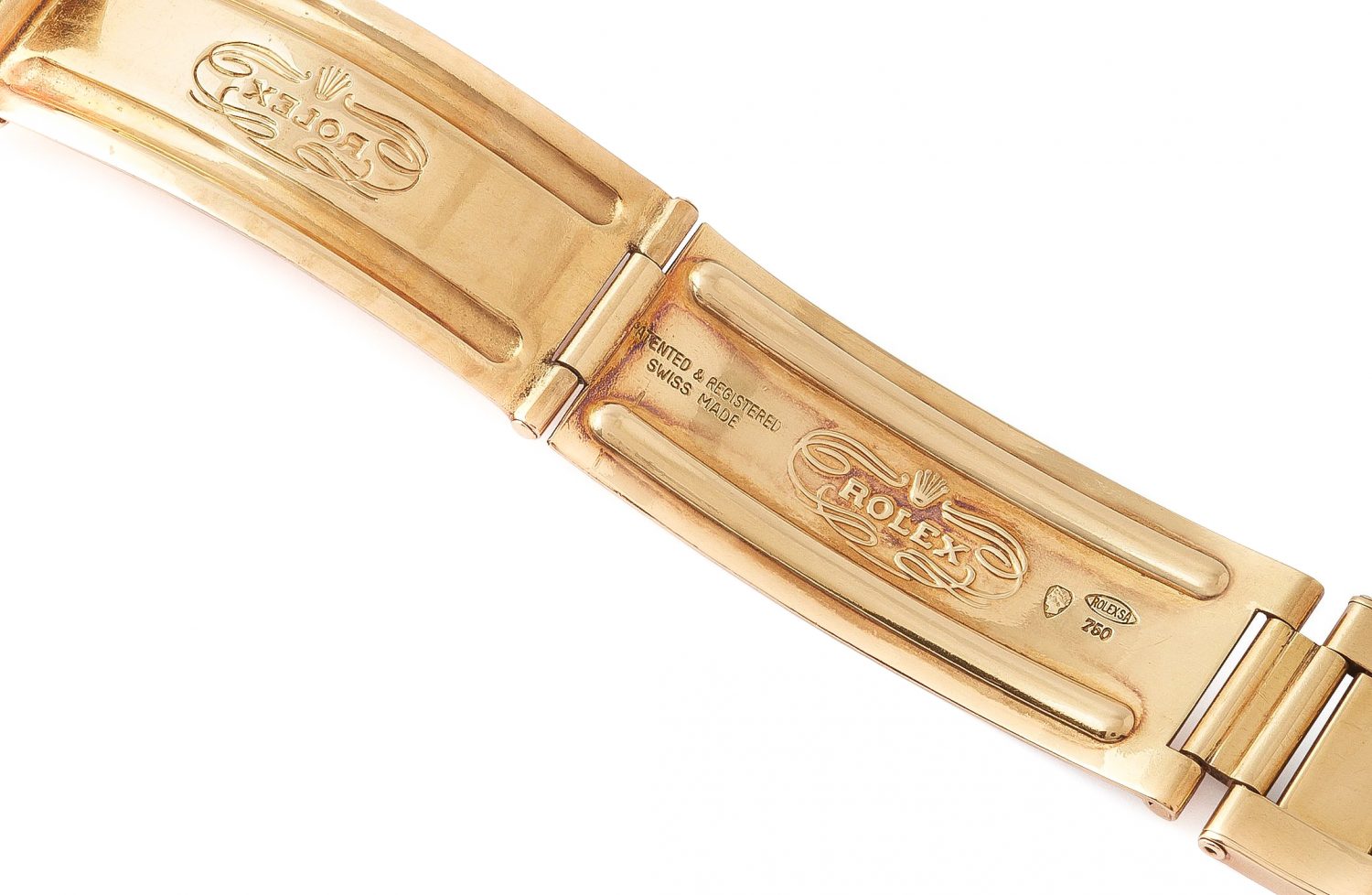
Poinçons de Maître
In the 1920s, a new hallmarking system specifically for precious-metal watch cases was introduced. Poinçons de Maître can be directly translated to ”Master’s hallmarks”. These hallmarks were used to identify the maker of precious metal watch cases.
The master’s hallmarks are required by law since 1933 and can be found on all precious metal watches. The master’s hallmarks are different symbols, such as camels, shields, etc, with a number inside. The symbol together with the number makes it unique for each maker of the case.
This allows you to identify who manufactured the case, and, for example, if it was externally manufactured.
Rolex hallmarks pre-today and today
All precious metal Rolex watches are stamped with a number of different marks. You are already aware of the mark that tells us the fineness of the metal, for example, 18k, 14k, etc. This metal engraving is also accompanied by additional stamps, and these are what are known as hallmarks.

The most common precious metal watch case is 18K gold, and therefore, the most common hallmark is a pictured lady, known as Helvetia. All 18K gold cases made in Switzerland have the Helvetia hallmark. Furthermore, the hallmark for 14K gold is a squirrel and a mountain goat for platinum watch cases.

In 1995, the hallmarks changed. Now, a hallmark of a St Bernards head is used.
Today in Switzerland, only watch cases made in precious metal must be hallmarked. Other jewelry and cutlery do not need to be hallmarked.
Today, there are several Assay offices in Switzerland, but Rolex, in particular, which we focus on in this article uses the office that is located in Genève, which is natural as it is where Rolex has its main office.

The Assay office located in Switzerland uses the marking ”G”. These are called town marks. In addition to the hallmark, depending on where the Assay office is located, different letters are used, as seen in the list below
- Biel / Bienne = B
- Basel = *
- Chiasso = T
- Geneva = G
- La Chaux-de-Fonds = C
- Le Noirmont = J
- Zurich = Z
With that said, different Swiss watch manufacturers can use different assay offices.
What is also worth pointing out is that the same hallmark applies to all colors of gold. It does not make a difference depending on which color the gold is. The hallmarks are generally tiny which makes it difficult to notice their details. But if you look closely, for example with a loupe, you will be able to see the level of detail. As a matter of fact, all hallmark symbols mean something.
When it comes to Rolex hallmarking, you can find hallmarks on the band clasp, mid-case, and case back on all Rolex watches which are made in full precious metal. Most of the brand’s ranges are available in full gold options, with the exception of a few, such as the Explorer and Sea-Dweller.
To some extent, hallmarks can be used to identify if your watch is authentic, however, as the counterfeiters get better, it’s by no means any guarantee that your watch is authentic if it has the hallmarks. The hallmarks are governmental and have an impressive level of detail. It is the Swiss government that controls the quality of the hallmarks and the fineness of the gold. The government is responsible for the dies used.
Hallmark standards
The hallmark standard refers to the legal minimum fineness of the precious metal. In other words the proportion of precious metal in the alloy vs base material. 18K gold, for example, is often written 750, which means 750/100. In other words, at least three-quarters of the weight is gold. If it does not have this fineness, it will not be hallmarked as 18K gold.
The old symbols of the hallmarks are as follows: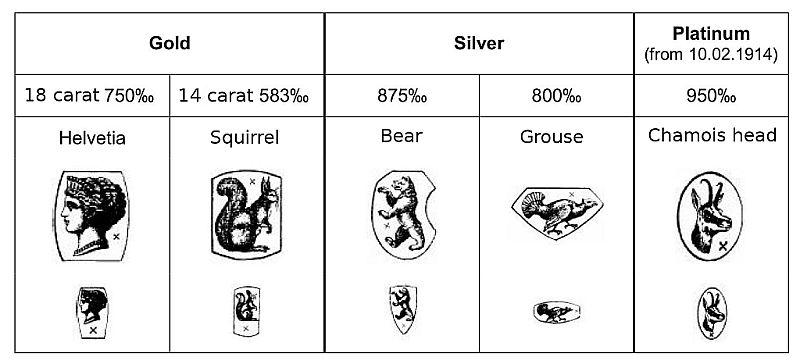
Swiss official hallmarks for watch cases from 1880 to 1933
Hallmarks for importing
Due to different countries’ laws regarding imports, some countries require additional hallmarks on precious metal watch cases. One example is Sweden, which required the hallmarks as seen below for the import of precious metal cases:
Many of the import hallmarks rules for different countries have been removed, but many countries still require them. This is why you may see precious metal Rolex watches that have different hallmarks.
Why Does Rolex not use hallmarks for two-tone watches?
Most of the time, Rolex does not use hallmarks for its two-tone watches. The main reason is that it is not a legal requirement. There are however some exceptions in the history of countries that required all gold parts on the gold and steel watches to be hallmarked as well, but this is not the case anymore. Do note, however, that these hallmarks were not done by Rolex.
Some gold parts of gold and steel Rolex watches do have hallmarks, for example, the fluted bezel has two Rolex crowns marked at 12 o’clock and 6 o’clock.

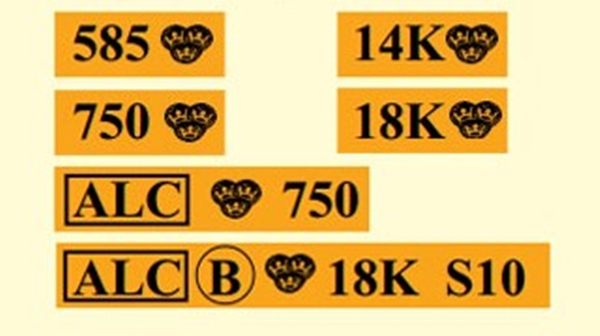




Hi
I was reading the artikel about: Rolex Hallmarks Complete Guide, on this site.
And a question came to mind,..
I purchased Recently a Rolex 126711 CHNR(rootbeer) at a AD in France.
I have a ‘stamp’ on the lug says
‘Sté*r’ (* = crown image)
And on the bracelet stand ‘RO’ And again the same logo.
I don’t find any info about this stamps.
Other 126711 models don’t seems the have those stamps.
can you maybe help me with some info?
thanks in advance
Gr.W
Hi,
This is a French import stamp. This is the case for all French-imported Rolex watches.
Kind regards,
Millenary Watches
Hi do they have date hallmarkings on the bracelets
Hi,
Some vintage bracelets have clasp codes with which you can date the bracelet, but not all.
Kind regards,
Millenary Watches
Hi i am purchase second hand watch lady oyster perpetual datejust in the back dial stamping 750 it’s a yellow gold Or Wight goals second side is 18k
Nice! Enjoy it!
Kind regards,
Millenary Watches
I have a gold President band that has no Rolex markings on it, just an Italy stamp, does this mean it’s fake? It does have the Rolex clasp.
Yes, that should mean it is not original.
Kind regards,
Millenary Watches
Hi, I have my rolex day date from my mom. wondering if it’s fake or not. it has 18k stamp and also steelinox? let me know. Thanks.
Hi,
You can authenticate your watch here:
https://millenarywatches.com/watches/watch-consulting/
Kind regards,
Millenary Watches
Hello, I bought a Tudor Bicolore steel 18k rose gold 1926. I have a rolex master’s mark on one of the lugs of the watch (sté courrone R). And on a gold link the same hallmarks with the word “OR” written above. I have read that this is the case with all Rolex watches imported into France.
In reality it would seem that this only concerns models with gold.
Thanks to my AD I was able to have the overall weight of 750 gold for my watch in 36mm, 8g.
I was surprised because the links are capped, does this mean that in France gold capping is recognized as a solid gold? Knowing that there is a lot of hollow gold in jewelry with thicknesses of 0.08mm (against 0.2mm for the links). Perhaps this is why France is asking Rolex for additional hallmarks for their two-tone models?
Hi,
All Rolex/Tudor watches that contain gold which are imported into France have hallmarks. The hallmarking rules are rather complex, but they have been hallmarking both solid gold and two-tone watches for a long time.
Kind regards,
Millenary Watches
I have a very old gold Rolex pocket watch. On the face it shows “Rolex”, “Precision” and “Swiss Made”. One the back it just shows a Coronet with the word “Rolex” across the bottom of it. Do you know how old this watch would be?
Hi,
It’s hard to say without further details as Rolex produced pocket watches with these markings for quite some time.
You should have a serial number on the watch that you can use to look up when exactly the watch was produced by using this resource here:
https://millenarywatches.com/rolex-serial-numbers/
Kind regards,
Millenary Watches
I have had my Rolex Oyster DateJust since new purchased 1969 which has the following markings on the bracelet: the number “4” on top of the number “69” the words “patented & registered” and “Swiss made” and “Steelinox 6521H” and the number “55”. It has black dial with gold digits and the customary Rolex fluted bezel. I have all the paperwork and certificate and would like to know which particular model it is and current value. The certificate bears some numbers but not the model number.
That sounds like a beautiful classic watch!
6521H is the bracelet reference number which tells what bracelet it is. “55” sounds like the end link code to indicate the type of end links used. 69 is the year of production for the bracelet and “4” likely refers to the 4th month, meaning April.
Kind regards,
Millenary Watches
If a ladies Justdate case does not have any hallmarks is it fake
Hi,
That is not entirely true since only watches made in gold have hallmarks. If it is in steel, it will not have any hallmarks.
Kind regards,
Millenary Watches
I have a Rolex watch ( no band). The markings on the 6 o’clock side are 1. a tombstone shape with KR 2. a rectangle with the number 20. The serial number is worn but looks like it started with 257. On the face is says ROLEX OYSTER PERPETUAL PRECISION MERITUS ROTOR SELF WIND. It still works but it is worn. What are these markings? Would it be worth restoring?
Hi,
Most Rolex watches are certainly worth restoring.
It sounds like you have an Oyster Perpetual 6594 from approx 1940s-1950s. This watch is powered by the Rolex caliber 1030. This watch has a stainless Steel Back, acrylic glass, a gold-plated case, and a screw-down crown.
The Meritus is quite unique as it was only made for the Canadian market.
Kind regards,
Millenary Watches
Hi, I’m looking at buying a Rolex Oyster 6426 Precision. I’m trying to work out whether it’s gold or just gold plate. The inside of one of the lugs has a recessed stamp on it that sort of looks like a sheaf of wheat but doesn’t look like any of the Rolex hallmarks described in your very helpful article. Can I send you a photo of the stamp, please?
Have you seen that stamp before and, if so, what does it represent please?
Hi,
The 6426 was only made in gold with gold plating, or more correctly “gold filled”. There is no 6426 in solid gold.
Hope this helps!
Kind regards,
Millenary Watches